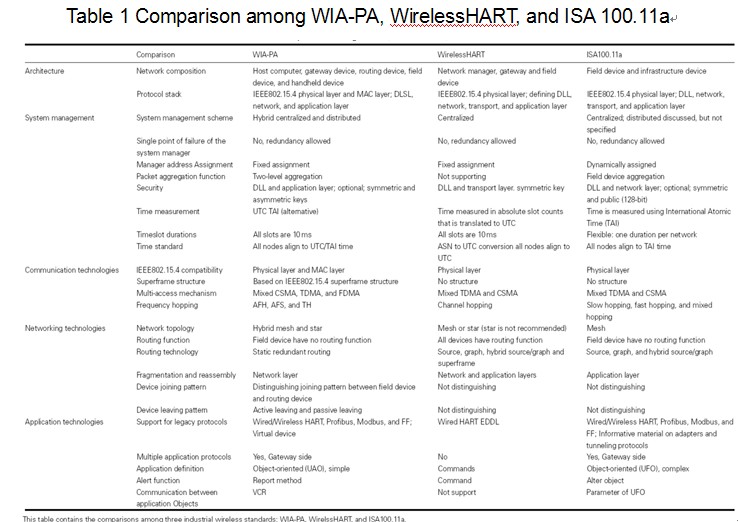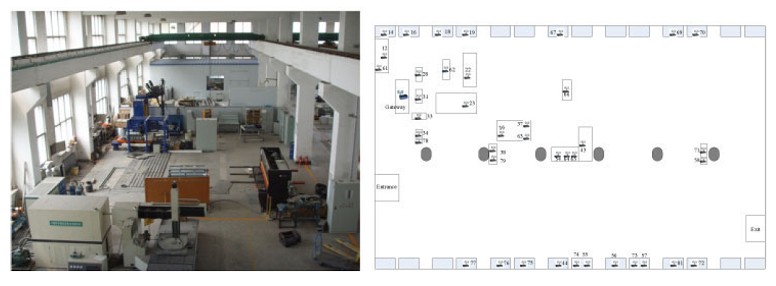Wireless process control has been a popular topic recently in the field of industrial measurement and control. Wireless technology makes industrial measurement and control systems to be low cost, easy to use and maintain, and has more broad potential applications. However, application development of industrial wireless network is slow due the lack of an ideal standard. Open standards are the foundation of industrial wireless application extensions.
Recently, some international organizations have been actively promoting the standardized process of industrial wireless network and have achieved several productions, such as Wireless HART, ISA 100.11a, and the Wireless network for Industrial Automation Process Automation (WIA-PA).
Specifically, Chinese Industrial Wireless Alliance (CIWA) was established by Shenyang Institute of Automation in 2007 and developed WIA-PA that is a kind of system architecture and communication protocol of wireless networks for industrial process automation under the urgent requirements of process automation. WIA-PA adopts characteristic schemes, such as two-stage communication resource allocation, adaptive frequency hopping, and two-level packet aggregation to solve some special problems of industrial process applications.
To understand the WIA-PA standard in detail, the researchers from Shenyang Institute of Automation, Chinese Academy of Sciences (CAS) provided a survey for WIA-PA and compared it with two other industrial wireless specifications. The network topology of WIA-PA is shown in Figure 1.

Figure 1 Network topology of WIA-PA (hybrid mesh and star) (Image by LIANG Wei et.al.)
The key technologies of WIA-PA can be concluded as follows:
l Hybrid centralized and distributed management scheme;
l Superframe-based resource allocation scheme;
l Multi-access and adaptive frequency hopping mechanisms;
l Packet aggregation and dis-aggregation.
(See paper “Survey and Experiments of WIA-PA Specification of Industrial Wireless Network” for more details of these technologies.)
Next, the researchers compare WIA-PA, WirelessHART, and ISA 100.11a from five aspects listed in Table 1: architecture, system management, communication technologies, networking technologies, and application technologies.

WIA-PA has been realized on a real physical test-bed, which includes the gateway platform realized on ARM9, and node platform realized on MSP430. Besides, the performance of WIA-PA network has been test by physical experiments conducted in a small factory. The experiment scenario is shown in Figure 2.

Figure 2 Experiment scenario (Image by LIANG Wei et.al.)

Figure 3 Overhead comparison between distributed and centralized algorithms (Image by LIANG Wei et.al.)

Figure 4 Transport success rate of different channels (Image by LIANG Wei et.al.)

Figure 5 Transport success rate of different packet lengt (Image by LIANG Wei et.al.)
Figure 3 illustrates that the calculation time of the two-stage scheme is obviously better than the centralized one and the packet overhead of the WIA-PA scheme is lower than the centralized one. Figure 4 illustrates the results of transport success rates for different channels with increased of packet counts. The blacklist technology of WirelessHART is static and can be used to simply screen networks from using bad channels, as in channel 16. If an adaptive frequency hopping strategy is used, the worst channels can be filtered dynamically, as in channels 17, 18, and 20. Figure 5(a) shows the change in the transport success rate for different packet lengths with the increasing of packet counts. When the channel conditions are worse, the transport success rates are low. Figure 5(b) describes the change trend of average transport success rate with increasing packet length. The cure graph shows that the change in the average transport success rate has not changed a lot within certain a range of packet lengths.
This work was published on the journal of WIRELESS COMMUNICATIONS AND MOBILE COMPUTING, Volume 11, Issue 8, August 2011, 1197-1212. It was partly supported by the Natural Science Foundation of China under contact numbers60704046 and 60725312, National high-tech research development plan (863 plan) of China under contract 2007AA04Z173 and 2007AA041201, and the US National Science Foundation (NSF) under grants #: CNS-0716211 and CCF-0829827.
CONTACT:
Prof. LIANG Wei
Shenyang Institute of Automation, Chinese Academy of Sciences
Email: weiliang@sia.cn